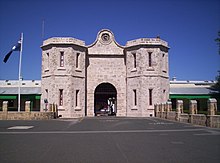History of Fremantle Prison
A new superintendent with outside experience, Hugh Hann, was appointed, and supported by the newly elected Labor government interested in penal reform.
Growing prisoner discontent culminated in a 1988 riot with guards taken hostage, and a fire that caused $1.8 million worth of damage.
This arrangement was quite arduous for the sheriff, who spent much of his time rowing a small boat, either to transfer prisoners or bring over their meals.
It was not until September 1830 that work started on a new prison at the west end of High Street: the twelve-sided Round House on Arthur Head.
[1]: 13–14 While the Swan River Colony was established as a "free settlement",[2] by the 1840s the early reluctance to accept Britain's convicts was overcome.
There was also no prepared accommodation for the warders, pensioner guards, Captain Edward Walcott Henderson, Comptroller General of Convicts, or his clerk, James Manning.
Whilst he favoured Mount Eliza due to its height, which gave it pleasing vistas and supposedly healthier air, Governor Charles Fitzgerald rejected that proposal.
Pentonville, designed by Joshua Jebb, used the "separate system" that kept prisoners in nearly complete isolation, to encourage reflection on their crimes.
[3]: 2 Construction began soon afterwards, supervised by Henderson, Manning, and Royal Engineer lieutenant Henry Wray, who had arrived with another convict ship.
The foundations were laid in 1857, but the plans were changed the next year to provide additional space to isolate contagious or dangerous patients.
The section was finished in 1855, including the association wards, a circular jarrah stairwell, and 18 solitary confinement cells in the Refractory Block.
Anxious for the new cell block to start being used, Henderson ordered that doors and rails be made locally, with iron salvaged from convict transport ships.
[1]: 45–46 The Western Australian gold rushes of the 1890s resulted in strong economic growth, and a massive increase in population: doubling from almost 50,000 in 1891 to more than 100,000 by 1895, and expanding to 184,000 by 1901.
In particular, they considered the philosophy of the prison system – the causes of crime, as well as the types of punishments and their justifications – and in light of this, the practicality of various reform proposals.
Internal walls were constructed in the main block, creating four separate divisions:[7]: 12–13 Following the urgings of Superintendent George and various official enquiries, new workshops were built to provide increased useful employment for prisoners.
The western workshops, located between the entry complex and the Female Division, were built from 1900–1901 of squared limestone rubble with openings dressed in brick.
An open saw-tooth roof with southern skylights covered the five spaces designed for the five traditional workshops: tailors, bookbinders, shoemakers, mat makers and painters.
[9] The new division, built by contractors with stone from quarries at Rottnest Island,[1]: 50 was similar in design to Henderson's 1850s structure,[9] but was constructed in an L-shape, was only three stories tall, and had electric lighting, with cables laid underground for safety as well as aesthetics.
Unlike the earlier building, prisoners remained continuously in their somewhat enlarged cells, except when exercised in separate yards watched by a warder in a central tower.
[11]: 4 However, there was a rapid change in prison policy, with the appointment of a superintendent, Hugh Hann, who had recent English and colonial experience, and the election of a Labor government with members interested in penal reform.
It shares with Katingal Special Security Unit in New South Wales the record for brevity of use of a permanent Australian penal structure.
[12] It was used for the detention of military personnel, as well as an internment centre[9] – one of more than 50 across Australia holding a combined total of more than 12,000 enemy aliens and prisoners of war.
[11]: 4 After the war Fremantle Prison returned to civilian use and a variety of ad hoc structures were erected on and below the knoll terraces.
[6]: 57 a place for rehabilitation and re-education ... where people can retain their identity and, if necessary, create a new identityThe appointment of Colin Campbell as comptroller general in 1966 fostered substantial changes within Fremantle Prison itself.
A university graduate with a major in psychology, he was the first senior appointment from outside the Western Australian prison system in almost half a century.
[6]: 63 The act was, however, slanted towards prisoner management and safety, as the government and opposition were mindful of public opinion, and the perception of lax security at Fremantle.
A private company organised the tourist operation for ten years under contract, until the end of 2001; subsequently, the state government took control.
[29] The process of obtaining World Heritage listing focused historical interpretation and conservation efforts on the prison's convict era, at the expense of its more recent history.
This aspect became more and more important through later plans by James Semple Kerr, authored in 1992 and reviewed in 1998, and subsequently in the state government's masterplan,[30] released in December 2000.
[31] The convict-era focus is reflected in the branding of the tourist experience as "Fremantle Prison – the Convict Establishment", and through restorations which, while necessary to prevent damage and deterioration, strip away the site's recent history.



